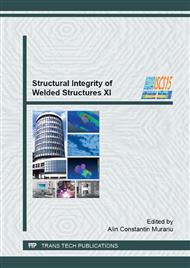p.110
p.116
p.121
p.127
p.133
p.139
p.145
p.151
p.157
Reduction of Cavitation Erosion of the Bronze CuAl10Ni5Fe2.5Mn1 by Laser Remelting Treatment
Abstract:
The paper presents a new procedure for bronze surface hardened by using intensive heating with laser beams (over 103 °C/s) which superficially melts the material. Afterwards the whole mass of the piece is subjected to blast cooling. For the used experimental conditions it was obtained a fine quenching microstructure with high harnesses, till 350 HV 0.5. The resulted structure has extremely fine grains which give an excellent resistance to cavitation erosions, because the dislocations movemement was heavily suppressed. Secondary, the residual compression tensions existing in the superficial layer delay the initiation of the cracks. Tertiary, the effects of bubble implosions are attenuated as a result of the holes realized on the surface by the laser beams treatment. Finally, the power of the laser beams upon the increase of the cavitation resistance was put into evidence.
Info:
Periodical:
Pages:
133-138
Citation:
Online since:
July 2015
Authors:
Price:
Сopyright:
© 2015 Trans Tech Publications Ltd. All Rights Reserved
Share:
Citation:


